Europe Building Automation Systems Market Size
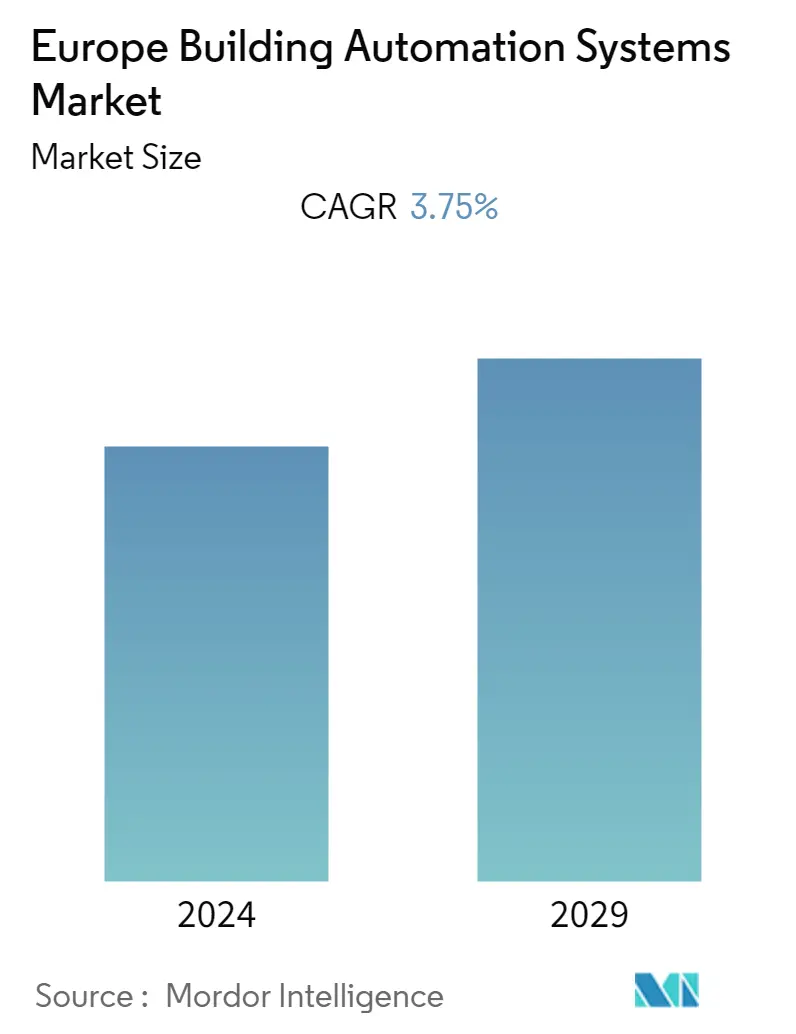
| Study Period | 2019 - 2029 |
| Base Year For Estimation | 2023 |
| Forecast Data Period | 2024 - 2029 |
| Historical Data Period | 2019 - 2022 |
| CAGR | 3.75 % |
| Market Concentration | Low |
Major Players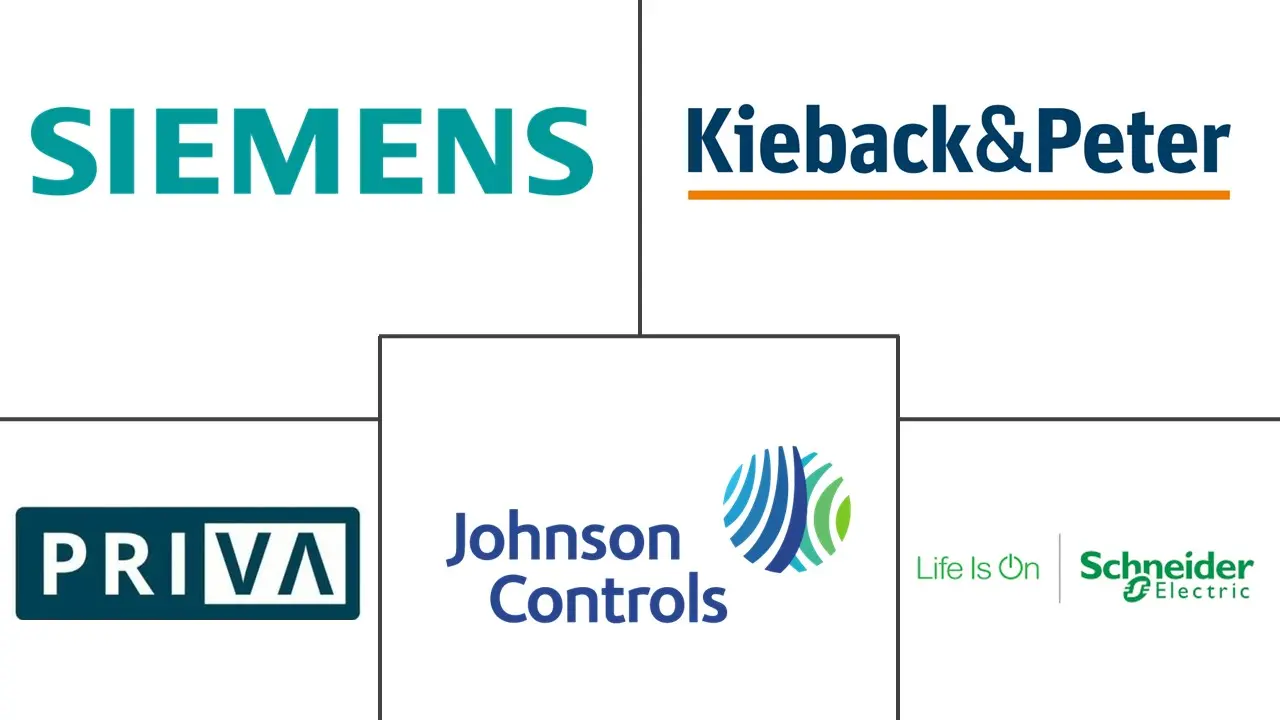
*Disclaimer: Major Players sorted in no particular order |
Europe Building Automation Systems Market Analysis
The Europe Building Automation Systems Market size is expected to grow from USD 3.67 billion in 2023 to USD 4.41 billion by 2028, at a CAGR of 3.75% during the forecast period (2023-2028).
- A building automation system (BAS), also referred to as a building control system or a building management system, is a system that controls several electric, electronic, and mechanical systems throughout a building. The report tracks the revenue accrued by companies through the sale of building automation solutions worldwide. Components like building management systems, lighting controls, fire detection, HVAC controls, and security systems are included in the scope of the study and span across end users, like residential and commercial.
- The building industry is essential to meeting the energy and environmental objectives of the EU. Better and more energy-efficient structures will also raise living standards for residents, reduce energy poverty, and benefit the economy and society by creating green jobs and other advantages like better indoor air quality and health.
- The demand for Internet of Things (IoT) products is growing across Europe. The region's IoT adoption is now being led by Germany, the United Kingdom, and the Netherlands, while Eastern Europe and the Nordics are closely trailing. Although the manufacturing, housing, health, and finance industries are leading the way in IoT adoption, the retail and agricultural industries are also experiencing significant development. Demand for outsourcing is still being driven by a lack of qualified specialists and a growing willingness to outsource.
- Technology for building automation systems (BAS) has advanced significantly and is always becoming better with new capabilities. It is noteworthy that many building managers still manually operate HVAC systems because they have little faith in the building automation system. Far too many buildings with perfectly functional building automation systems have their equipment being run manually by the building operators, whether due to a lack of understanding or the building automation system not being configured properly by the installation contractors.
- With the COVID-19 outbreak, most commercial and industrial construction projects started at a slow pace, while some were canceled. Production lines at some HVAC manufacturers had to be put on hold for several weeks, and installers saw their new installation projects limited by sanitary guidelines. However, in European countries such as Italy, AHU sales benefitted from the increased ventilation demand due to COVID-19. After the pandemic, commercial and industrial construction projects started, which propelled the market growth.
Europe Building Automation Systems Market Trends
Commercial Sector to be the Largest End User
- The commercial segment includes offices, hospitals, retail space, infrastructure, etc. Advancements in various technologies and the rapid increase in traction of the Internet of Things (IoT), the integration of artificial intelligence (AI), machine learning (ML), and smart sensors and technologies in various end-uses and appliances, devices, and products and appliances in commercial buildings are key factors expected to continue to support revenue growth in the market studied.
- As per the Buildings Performance Institute Europe (BPIE), building automation is cost-effective for essentially all commercial buildings, regardless of energy prices, usage, and climatic factors, provided it is correctly installed, commissioned, and operated. According to the organization, the average net energy savings per installation are about 37% for space heating, water heating, cooling, and ventilation, and 25% for lighting.
- Further, a regulatory decree in Europe requires all large non-residential buildings to be equipped with the main building automation functions by 2025. Such regulations also positively impact the market demand for this segment. In addition, the rising security concerns in commercial buildings also act as a driver for the market. Building automation systems can help improve security in a commercial building by controlling access to certain areas and monitoring activity. These systems can also help improve safety by detecting fires and other emergencies.
- The value of the commercial real estate market is increasing, further driving the studied segment and market. For instance, according to EPRA, in 2022, the value of the commercial real estate market in the United Kingdom (UK) was over USD 1.729 trillion, which was an increase from USD 1.559 trillion in the year before.
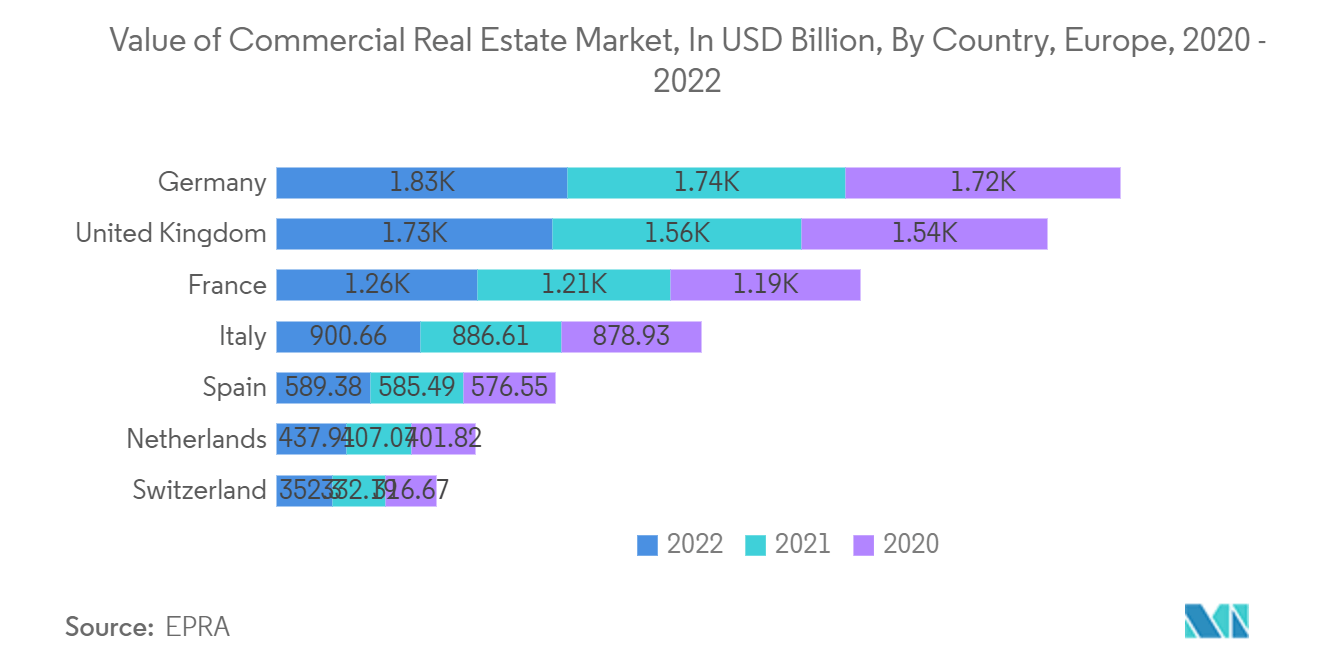
Germany to Hold Significant Market Share
- The rise in government policies toward energy-efficient products in the country is anticipated to drive the market. For instance, the revised Building Energy Act was published in the Federal Law Gazette on August 13, 2020. The Federal Ministry for Economic Affairs and Energy and the Federal Ministry of the Interior and Community proposed the Buildings Energy Act, which the Federal Government presented. On June 18, 2020, the German Bundestag approved the Building Energy Act. The Coalition Agreement, the choices made at the 2018 housing summit, and the actions outlined in the Climate Action Programme 2030 are all implemented through the Structures Energy Act, which governs laws governing energy efficiency in buildings.
- According to the Federal Statistical Office of Germany, in Germany, 129,000 residential construction permits and 29,000 non-residential building permits were issued in 2021. This was a higher number of permits for both types of structures than the previous year. Such massive construction permits will enable local and international building automation firms to develop new products according to the requirements of customers and capture market share.
- Furthermore, the market studied in Germany has witnessed significant growth due to a rise in infrastructure development along with growing demand for green buildings in the country. According to the OECD, Germany aims to raise the share of renewables from 17% currently to more than 80% in 2050 while phasing out electricity production from nuclear power plants by 2022. Greenhouse gas emissions have been cut by 40% recently and are estimated to be cut by at least 80% by 2050.
- The country is witnessing unprecedented demand spikes for smart door locks from residential end users. Established market participants capitalize on this demand by offering advanced smart door locks with several additional features. For instance, in September 2022, Ring announced a unique wireless intercom instrument aimed at apartment dwellers. This intercom is designed to connect with most building-wide intercom systems used by apartment complexes to vet visitors and buzz them in. This intercom allows auto-verification for Amazon deliveries and authorized guests, letting them buzz themselves in without needing a door code or an extra fob.
- Moreover, increasing construction activities and the rise in disposable income increased the adoption of building automation systems among a broader consumer base in the country. According to the Statistisches Bundesamt, the construction turnover in Germany was higher than in any civil engineering segment. Building construction has had the highest revenue during the whole timeline. In 2022, it recorded EUR 42.99 billion (USD 47.07 billion) in revenue from building construction.
- Moreover, the government's measures to create a climate-neutral building stock by 2050 are insufficient; the country's German Housing Association (GdW) and the CDU Economic Council are looking to shift to decentral heating. Such developments are expected to impact the heating equipment market over the coming years, further driving the studied segment.
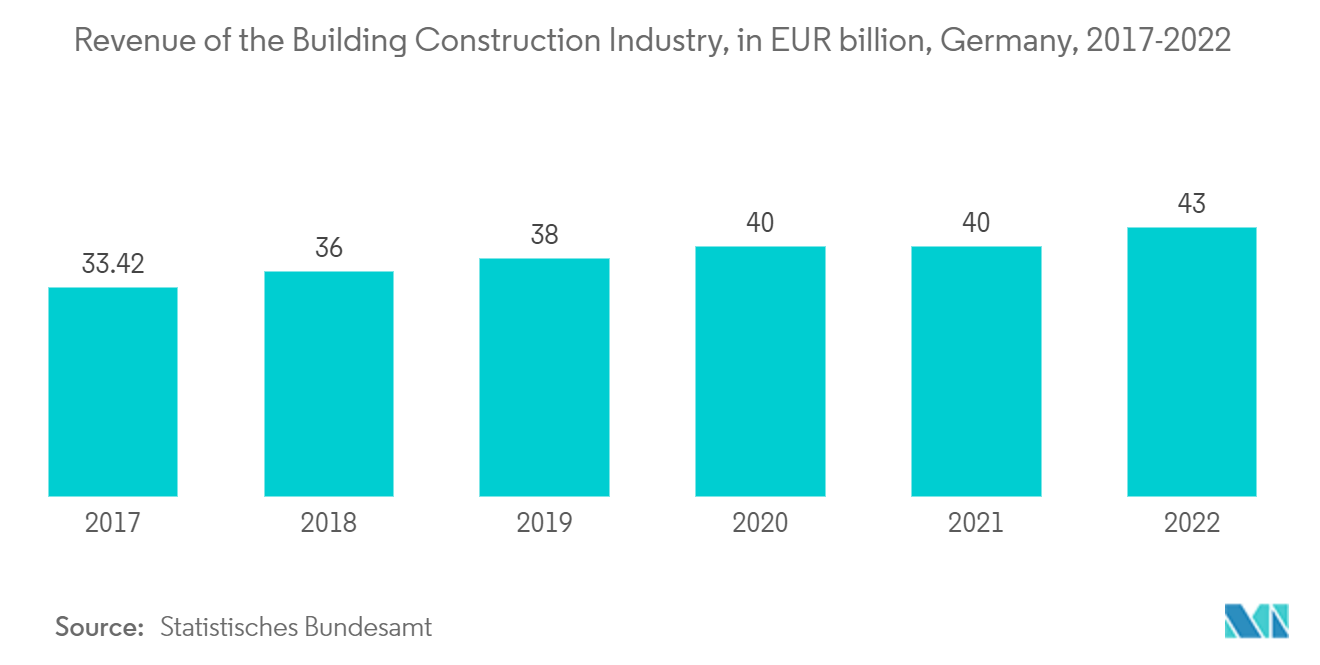
Europe Building Automation Systems Industry Overview
The competitive rivalry in the European building automation systems market is very high due to the presence of many key vendors. Some major players like Siemens AG, Johnson Controls International PLC, Kieback&peter Gmbh & Co. KG, Priva Holding BV, and Schneider Electric SE, among others. Players in the market are adopting strategies such as partnerships and acquisitions to enhance their product offerings and gain sustainable competitive advantage.
- May 2023: Johnson Controls expanded its residential and commercial contractor resource collection with the new Johnson Controls Ducted Systems (DS) Solutions App. The free app gives contractors instant access to commercial and residential equipment information to help streamline installation, troubleshooting, and maintenance processes. The app search for content by model number or scan an equipment QR code to access product-specific information quickly.
- April 2023: The Zero Carbon Building Systems (ZCBS) Lab at ETH Zurich is expected to be a one-of-a-kind research facility. It enables investigation into the behavior of building components and systems in various climate zones. As part of its industrial partnership with ETH Zurich, Siemens has equipped the new research facility with cutting-edge digital building technologies, including those for building operations and management. Siemens' Xcelerator portfolio includes these technologies.
Europe Building Automation Systems Market Leaders
-
Siemens AG
-
Johnson Controls International PLC
-
Kieback&Peter GmbH & Co. KG
-
Priva Holding BV
-
Schneider Electric SE
*Disclaimer: Major Players sorted in no particular order
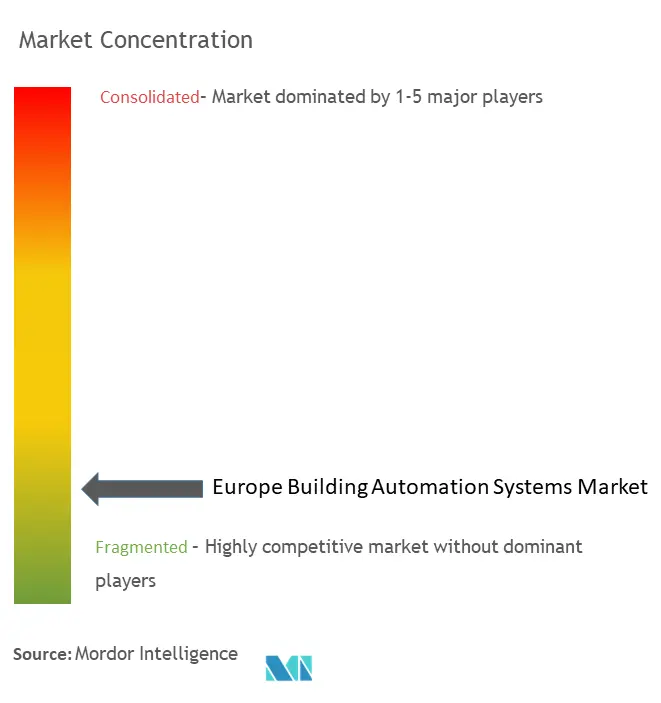
Europe Building Automation Systems Market News
- March 2023: Siemens Smart Infrastructure launched Connect Box, an open and easy-to-use IoT solution for small- to medium-sized buildings. The latest addition to the Siemens Xceleratorportfolio, Connect Box, is a user-friendly approach for monitoring building performance, with the potential to optimize energy efficiency by up to 30% and to substantially improve indoor air quality in small to medium-sized buildings such as schools and retail shops, apartments or small offices.
- March 2023: Schneider Electric announced the launch of EcoStruxureBuilding Operation for the Indian market to enhance occupant comfort and increase building value. With the introduction of the new solution, building owners can benefit from data that can be accessed, standardized, and secured with the help of artificial intelligence and machine learning.
Europe Building Automation Systems Market Report - Table of Contents
1. INTRODUCTION
- 1.1 Study Assumptions and Market Definition
- 1.2 Scope of the Study
2. RESEARCH METHODOLOGY
3. EXECUTIVE SUMMARY
4. MARKET INSIGHTS
- 4.1 Market Overview
-
4.2 Industry Attractiveness - Porter's Five Forces Analysis
- 4.2.1 Bargaining Power of Suppliers
- 4.2.2 Bargaining Power of Buyers
- 4.2.3 Threat of New Entrants
- 4.2.4 Threat of Substitutes
- 4.2.5 Degree of Competitive Rivalry
- 4.3 Industry Value Chain Analysis
- 4.4 Impact of Macro Economic Trends on the Industry
5. MARKET DYNAMICS
-
5.1 Market Drivers
- 5.1.1 Increasing Initiatives and Directives for Energy and Operational Efficiency
- 5.1.2 Rapid Growth of IoT in European Countries
-
5.2 Market Restraints
- 5.2.1 Absence of Technology Alignment and High Acquisition and Implementation Costs
6. MARKET SEGMENTATION
-
6.1 By Component
- 6.1.1 Hardware
- 6.1.1.1 Controllers
- 6.1.1.2 Field Devices
- 6.1.2 Software-as-a Service
-
6.2 By End User
- 6.2.1 Residential
- 6.2.2 Commercial
- 6.2.3 Industrial
-
6.3 By Country
- 6.3.1 Germany
- 6.3.2 United Kingdom
- 6.3.3 France
- 6.3.4 Nordics (Denmark, Sweden, and Finland)
- 6.3.5 Spain
- 6.3.6 Italy
- 6.3.7 Rest of Europe
7. COMPETITIVE LANDSCAPE
-
7.1 Company Profiles
- 7.1.1 Siemens AG
- 7.1.2 Johnson Controls International PLC
- 7.1.3 Kieback&Peter GmbH & Co. KG
- 7.1.4 Priva Holding BV
- 7.1.5 Schneider Electric SE
- 7.1.6 Robert Bosch GmbH
- 7.1.7 Trane Technologies PLC
- 7.1.8 Lynxspring Inc.
- 7.1.9 Belimo Holding AG
- 7.1.10 Sauter AG
- *List Not Exhaustive
8. VENDOR MARKET SHARE ANALYSIS
9. INVESTMENT ANALYSIS
10. FUTURE OF THE MARKET
** Subject To AvailablityEurope Building Automation Systems Industry Segmentation
Building automation systems exhibit functions such as control of the building's environment, operating systems depending on the energy demand, and monitoring the system performance, based on which the systems produce sound alerts as required. It centrally controls the building's heating, ventilation, air conditioning (HVAC), electrical, access control, and other interrelated systems.
The market is analyzed by tracking the components of building automation systems in terms of revenue generated across Europe. The scope covers automation controllers as per their application according to their specific or general functionalities. The integrated software is installed based on the configuration for controllers and supervisory software for computers. The field devices include sensors, actuators, valves, switch boxes, relays, and management field devices. As part of the vendor market share, only controllers and software are considered while arriving at the market shares. The impact of macroeconomic trends is also considered while forecasting market growth. Market players, including their key developments and growth trends, are studied for the global and European markets.
The Europe Building Automation Systems Market is segmented by Component (Hardware (Controllers and Field Devices), Software-as-a-Service), by End User (Residential, Commercial, Industrial), by Country (Germany, United Kingdom, France, Nordics (Denmark, Sweden, and Finland), Spain, Italy, Rest of Europe). The market sizes and forecasts are provided in terms of value in USD for all the segments.
| By Component | Hardware | Controllers |
| Field Devices | ||
| By Component | Software-as-a Service | |
| By End User | Residential | |
| Commercial | ||
| Industrial | ||
| By Country | Germany | |
| United Kingdom | ||
| France | ||
| Nordics (Denmark, Sweden, and Finland) | ||
| Spain | ||
| Italy | ||
| Rest of Europe |
Europe Building Automation Systems Market Research FAQs
What is the current Europe Building Automation Systems Market size?
The Europe Building Automation Systems Market is projected to register a CAGR of 3.75% during the forecast period (2024-2029)
Who are the key players in Europe Building Automation Systems Market?
Siemens AG, Johnson Controls International PLC, Kieback&Peter GmbH & Co. KG, Priva Holding BV and Schneider Electric SE are the major companies operating in the Europe Building Automation Systems Market.
What years does this Europe Building Automation Systems Market cover?
The report covers the Europe Building Automation Systems Market historical market size for years: 2019, 2020, 2021, 2022 and 2023. The report also forecasts the Europe Building Automation Systems Market size for years: 2024, 2025, 2026, 2027, 2028 and 2029.
Europe Building Automation Systems Industry Report
Statistics for the 2024 Europe Building Automation Systems market share, size and revenue growth rate, created by Mordor Intelligence™ Industry Reports. Europe Building Automation Systems analysis includes a market forecast outlook to 2029 and historical overview. Get a sample of this industry analysis as a free report PDF download.



